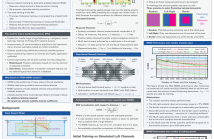
- Read more about A TWO-STEP LEARNING METHOD FOR DETECTING LANDMARKS ON FACES FROM DIFFERENT DOMAINS
- Log in to post comments
- Categories:
 14 Views
14 Views
- Read more about SEMI-SUPERVISED LEARNING OF CAMERA MOTION FROM A BLURRED IMAGE
- Log in to post comments
We address the problem of camera motion estimation from a single blurred image with the aid of deep convolutional neural networks.
Unlike learning-based prior works that estimate a space-invariant blur kernel, we solve for the global camera motion which in turn
- Categories:
 19 Views
19 Views
- Read more about Trajectory Optimization for Autonomous Flying Base Station via Reinforcement Learning
- Log in to post comments
In this work, we study the optimal trajectory of an unmanned aerial vehicle (UAV) acting as a base station (BS) to serve multiple users. Considering multiple flying epochs, we leverage the tools of reinforcement learning (RL) with the UAV acting as an autonomous agent in the environment to learn the trajectory that maximizes the sum rate of the transmission during flying time. By applying Q-learning, a model-free RL technique, an agent is trained to make movement decisions for the UAV. We compare table-based and neural network (NN) approximations of the Q-function and analyze the results.
- Categories:
 16 Views
16 Views
- Read more about On Deep Learning-based Massive MIMO Indoor User Localization
- Log in to post comments
We examine the usability of deep neural networks for multiple-input multiple-output (MIMO) user positioning solely based on the orthogonal frequency division multiplex (OFDM) complex channel coefficients. In contrast to other indoor positioning systems (IPSs), the proposed method does not require any additional piloting overhead or any other changes in the communications system itself as it is deployed on top of an existing OFDM MIMO system. Supported by actual measurements, we are mainly interested in the more challenging non-line of sight (NLoS) scenario.
- Categories:
 70 Views
70 Views
- Read more about Non-Linear Digital Self-Interference Cancellation for In-Band Full-Duplex Radios Using Neural Networks
- Log in to post comments
Full-duplex systems require very strong self-interference cancellation in order to operate correctly and a significant part of the self-interference signal is due to non-linear effects created by various transceiver impairments. As such, linear cancellation alone is usually not sufficient and sophisticated non-linear cancellation algorithms have been proposed in the literature. In this work, we investigate the use of a neural network as an alternative to the traditional non-linear cancellation method that is based on polynomial basis functions.
- Categories:
 46 Views
46 Views
- Read more about Self-paced mixture of t distribution model
- Log in to post comments
Gaussian mixture model (GMM) is a powerful probabilistic model for representing the probability distribution of observations in the population. However, the fitness of Gaussian mixture model can be significantly degraded when the data contain a certain amount of outliers. Although there are certain variants of GMM (e.g., mixture of Laplace, mixture of t distribution) attempting to handle outliers, none of them can sufficiently mitigate the effect of outliers if the outliers are far from the centroids.
- Categories:
 40 Views
40 Views
- Read more about Novel Realizations of Speech-driven Head Movements with Generative Adversarial Networks
- Log in to post comments
Head movement is an integral part of face-to-face communications. It is important to investigate methodologies to generate naturalistic movements for conversational agents (CAs). The predominant method for head movement generation is using rules based on the meaning of the message. However, the variations of head movements by these methods are bounded by the predefined dictionary of gestures. Speech-driven methods offer an alternative approach, learning the relationship between speech and head movements from real recordings.
- Categories:
 38 Views
38 Views
- Read more about Deep learning for predicting image memorability
- Log in to post comments
Memorability of media content such as images and videos has recently become an important research subject in computer vision. This paper presents our computation model for predicting image memorability, which is based on a deep learning architecture designed for a classification task. We exploit the use of both convolutional neural network (CNN) - based visual features and semantic features related to image captioning for the task. We train and test our model on the large-scale benchmarking memorability dataset: LaMem.
- Categories:
 127 Views
127 Views
- Read more about Using Block Coordinate Descent to Learn Sparse Coding Dictionaries with a Matrix Norm Update
- Log in to post comments
Researchers have recently examined a modified approach to sparse coding that encourages dictionaries to learn anomalous features. This is done by incorporating the matrix 1-norm, or \ell_{1,\infty} mixed matrix norm, into the dictionary update portion of a sparse coding algorithm. However, solving a matrix norm minimization problem in each iteration of the algorithm
- Categories:
 34 Views
34 Views
- Read more about COMPARING THE INFLUENCE OF DEPTH AND WIDTH OF DEEP NEURAL NETWORK BASED ON FIXED NUMBER OF PARAMETERS FOR AUDIO EVENT DETECTION
- Log in to post comments
Deep Neural Network (DNN) is a basic method used for the rare Acoustic Event Detection (AED) in synthesised audio. The structure of DNNs including Multi-Layer Perceptron (MLP) and Recurrent Neural Network (RNN) for AED tasks has rather fewer hidden layers compared with computer vision systems. This paper tries to demonstrate that a DNN with more hidden layers does not necessarily guarantee a better performance in AED tasks.
- Categories:
 125 Views
125 Views